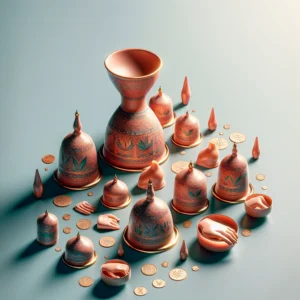Discover the Transformative Benefits of Hijama Wet Cupping Therapy for Your Health
Hijama, commonly known as wet cupping therapy, is an ancient healing practice that utilizes suction cups to draw blood from the skin's surface. This specialized technique involves making a small incision to facilitate the blood's exit, which is believed to aid the body in its detoxification processes by eliminating harmful toxins. The cups can be crafted from various materials, including glass, bamboo, or silicone, and are strategically placed on targeted areas of the body to create a vacuum effect. This method not only boosts blood circulation but also fosters comprehensive health and well-being.
During a Hijama session, the suction created is thought to stimulate blood flow and amplify the body's innate healing abilities. Many individuals report experiencing a unique sensation of tightness or pulling at the locations where the cups are applied. Despite its unconventional approach, numerous patients find the therapy to be incredibly calming, often leading to profound relaxation and an enhancement in overall wellness following their session.
For those unfamiliar with Hijama, its therapeutic benefits have gained considerable acknowledgment, making it an increasingly sought-after option within holistic health circles. As you explore the intricacies of this time-honored practice, you may develop a deeper appreciation for its unique role in promoting personal health and well-being.
Key Benefits and Insights into Hijama Wet Cupping Therapy
- Experience the power of Hijama Wet Cupping Therapy, a time-honored alternative medicine technique designed to facilitate healing and enhance blood flow.
- With historical roots spanning various ancient cultures, including Egyptian, Chinese, and Middle Eastern civilizations, this natural remedy has addressed numerous health challenges for centuries.
- The numerous advantages of Hijama Wet Cupping Therapy include pain relief, improved circulation, detoxification, and an overall sense of relaxation.
- This technique involves making small incisions on the skin and applying cups to extract blood and impurities from the body.
- Conditions such as migraines, back pain, arthritis, and respiratory disorders can be effectively treated through Hijama Wet Cupping Therapy.
 Delving into the Historical Significance and Evolution of Hijama Wet Cupping Therapy
Delving into the Historical Significance and Evolution of Hijama Wet Cupping Therapy
The roots of hijama trace back thousands of years, with documented references in ancient Egyptian, Greek, and Chinese medical writings. Hippocrates, often referred to as the father of modern medicine, notably highlighted its effectiveness in treating a wide range of health issues. Within Islamic traditions, Hijama holds a revered status, frequently mentioned in Hadiths—the sayings attributed to the Prophet Muhammad—underscoring its importance in these cultures.
This cultural endorsement has solidified Hijama's enduring popularity, particularly among Muslim communities. By examining the extensive history of Hijama, one can uncover its dual purpose: addressing physical ailments while also promoting emotional and spiritual healing. Ancient practitioners believed that by removing stagnant blood and toxins, they could restore both physical vitality and emotional harmony.
Over the centuries, Hijama has transformed, incorporating diverse techniques and philosophies from various cultures, resulting in the contemporary practice recognized today. Today, Hijama is embraced worldwide, with practitioners adapting traditional methods to meet modern health needs.
Unveiling the Extensive Therapeutic Benefits of Hijama Therapy
The therapeutic advantages of Hijama wet cupping therapy are both wide-ranging and profound. Many individuals report significant relief from chronic pain conditions, such as migraines, back pain, and arthritis, following treatment. The suction created by the cups is believed to enhance circulation, potentially leading to reduced inflammation and accelerated recovery from injuries.
Beyond physical relief, many individuals find that Hijama alleviates stress and anxiety, contributing to an overall enhancement of their well-being. Practitioners often associate Hijama with detoxification, as the procedure is believed to effectively remove impurities from the bloodstream. This cleansing action can lead to increased energy levels and a fortified immune response.
As you contemplate the potential benefits of this therapy, it's crucial to understand that individual experiences may vary significantly. While some patients may experience substantial relief, others may not notice immediate changes. Nonetheless, many practitioners advocate for regular sessions as a vital component of a holistic health and wellness strategy.
 A Comprehensive Guide to the Hijama Process: What to Expect
A Comprehensive Guide to the Hijama Process: What to Expect
Upon your arrival for a Hijama session, your practitioner will initiate a conversation regarding your health history as well as any specific concerns you wish to address. This initial consultation is crucial for tailoring the treatment to your individual needs. After ensuring your comfort, the practitioner will identify specific areas of your body for treatment, often focusing on points that correspond with your symptoms or areas of tension.
The therapy typically begins with dry cupping, where cups are applied to your skin to create suction without making any incisions. After a brief period, the cups are removed, and small incisions are made on the skin using a sterile blade or lancet. The cups are then reapplied to extract a controlled amount of blood.
While this part of the procedure may seem intimidating, many individuals describe only minimal discomfort during the incisions. Each session usually lasts between 30 minutes to an hour, depending on your customized treatment plan.
Identifying Conditions and Ailments Targeted by Hijama Therapy
Hijama wet cupping therapy is utilized to alleviate a diverse range of conditions and ailments. Numerous practitioners endorse its effectiveness for managing musculoskeletal issues, including back pain, neck pain, and joint discomfort. Athletes frequently seek out Hijama for muscle recovery and injury prevention, thanks to its capacity to improve circulation and diminish inflammation.
In addition to alleviating physical pain, Hijama is also believed to provide relief for respiratory conditions such as asthma and bronchitis by enhancing lung function and aiding in mucus clearance. Some individuals pursue this therapy to address digestive problems and hormonal imbalances. As you explore the various applications of Hijama, it's essential to consult with a qualified practitioner who can guide your treatment in accordance with your specific health concerns.
 Crucial Safety Considerations and Possible Risks of Hijama Wet Cupping
Crucial Safety Considerations and Possible Risks of Hijama Wet Cupping
While Hijama wet cupping therapy is generally regarded as safe when performed by a trained professional, there are several risks and precautions to consider. Temporary side effects, such as bruising or mild discomfort at the cupping or incision sites, may occur; however, these effects usually resolve within a few days.
It's crucial to ensure that your practitioner adheres to stringent hygiene protocols to minimize the risk of infection. Certain individuals should approach Hijama with caution or avoid it altogether. If you have bleeding disorders, are pregnant, or suffer from specific skin conditions, it's essential to discuss these factors with your practitioner prior to undergoing treatment.
By staying informed about potential risks and maintaining open communication with your provider, you can make an educated decision regarding the suitability of Hijama for your wellness journey.
The Growing Popularity of Hijama: A Modern Trend in Holistic Health
Recently, there has been a significant resurgence of interest in alternative therapies, particularly Hijama wet cupping therapy. As more individuals seek holistic health solutions, this ancient practice has regained its importance in both Eastern and Western societies. Social media has played a pivotal role in spreading awareness and information about Hijama, with many users sharing their positive experiences and outcomes online.
The increasing popularity of Hijama can be attributed to a broader acceptance of integrative medicine, which merges traditional treatments with alternative therapies for a more holistic approach to healthcare. As you delve into this trend, you may notice that more wellness centers and clinics are incorporating Hijama into their service offerings, making it increasingly accessible for those interested in exploring its potential benefits.
 Your Guide to Finding a Skilled Practitioner for Effective Wet Cupping Therapy
Your Guide to Finding a Skilled Practitioner for Effective Wet Cupping Therapy
Finding a qualified practitioner for Hijama wet cupping therapy is crucial to ensure both safety and effectiveness throughout your therapeutic experience. Start by searching for local practitioners who specialize in this therapy; many holistic health centers or acupuncture clinics often include Hijama as part of their wellness offerings. It's essential to seek practitioners who possess formal training in cupping techniques and have a proven history of successfully treating various health conditions.
Before booking your session, consider contacting potential practitioners for an initial consultation to discuss your health concerns and inquire about their treatment approach. A reputable practitioner will invest time in understanding your needs and provide a comprehensive explanation of the treatment process. Additionally, reading reviews or seeking recommendations from friends or family can help you find a practitioner aligned with your health and wellness goals.
By taking these informed steps, you can embark on your journey into Hijama therapy with confidence, assured that your chosen practitioner possesses the necessary skills and expertise.
Common Questions About Hijama Wet Cupping Therapy
What is Hijama wet cupping therapy?
Hijama wet cupping therapy is a traditional alternative medicine modality in which a therapist applies cups to the skin to create suction, believed to enhance healing by increasing blood flow and alleviating inflammation.
How does Hijama wet cupping therapy work?
During Hijama wet cupping therapy, the therapist makes small incisions on the skin and places a cup over the incision to create suction. This process draws a small amount of blood, which is thought to help eliminate harmful substances from the body and promote healing.
What potential benefits does Hijama wet cupping therapy offer?
Proponents of Hijama wet cupping therapy assert that it can assist with a variety of conditions, including pain relief, inflammation reduction, improved blood circulation, detoxification, and enhanced relaxation. However, scientific backing for these claims remains limited.
Is Hijama wet cupping therapy safe?
When conducted by a qualified and trained therapist, Hijama wet cupping therapy is generally considered safe. However, there is a risk of infection if proper hygiene and sterilization procedures are not followed, highlighting the importance of receiving treatment from a reputable and experienced practitioner.
What side effects might occur from Hijama wet cupping therapy?
Some potential side effects of Hijama wet cupping therapy may include temporary discomfort, bruising, and mild skin irritation at the cupping site. Rarely, there may be a risk of infection or scarring.
Who should avoid Hijama wet cupping therapy?
Hijama wet cupping therapy is not recommended for individuals with specific medical conditions, such as hemophilia, leukemia, or those who are pregnant. Consulting with a healthcare professional before undergoing this therapy is essential, particularly for individuals with underlying health concerns.
Presented By: Hijama Therapy
The Article: Hijama Wet Cupping Therapy Benefits You Should Know appeared first on https://mcrtherapies.co.uk
The Article Benefits of Hijama Wet Cupping Therapy You Need to Know appeared first on https://mcrtherapies.com/”>https://mcrtherapies.com
The Article Hijama Wet Cupping Therapy: Essential Benefits to Discover Was Found On https://limitsofstrategy.com

